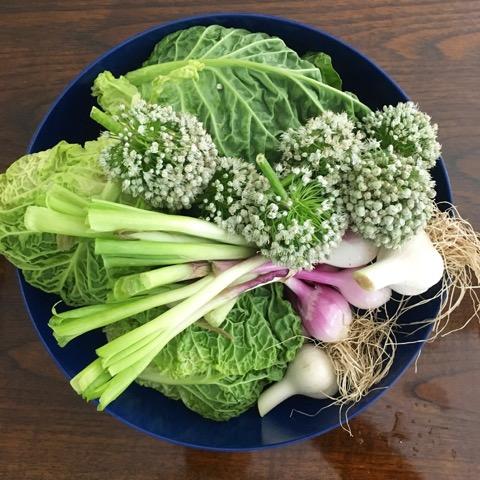![]()
Ahh, Summer. After such a long, cold winter, I’m sure that many of us are now happily enjoying warmer temperatures, longer days, flowers in bloom, and of course, seasonal produce. For me, there is nothing quite like the taste of the season’s first tender asparagus and leafy greens, or the sweet berries, melons, and peaches that appear at the Farmer’s Market soon thereafter. The flavors and freshness of the fruits and vegetables that are locally grown and in season are unlike anything else that we find in our supermarkets all year round.
When we eat with the seasons, we are making a choice that reaps multiple benefits:
First, to our Health: Fruits and vegetables that are picked at the peak of freshness and are locally grown not only taste better, but they have higher nutritional value than produce that is shipped to us from across the country or from other parts of the world. The concentration of antioxidants is higher, the vitamin and mineral content is more potent, and our bodies seem to assimilate them better. Eating the variety of foods that are available each season also affords us the opportunity to diversify our diets and experiment with produce that we might not otherwise try. And diversity in our diets adds significant health benefits. According to Rachel Meltzer Warren, MS, one study that looked at the health benefits accruing to women who routinely ate a diet rich in colorful fruits and vegetables from 18 different plant families showed that they had “significantly less damage to their genetic material than women who limited themselves to five plant families.” Variety, therefore, does more than just make food more interesting. It actually protects our health.
Second, to the Local Farmer: When you buy seasonal, locally grown foods, you are helping to support the regional farmers who depend on these crops for their livelihoods. In so doing, you are helping to keep your farmers in business while boosting your local economy. Locally grown foods also tend to be less expensive than the foods you purchase elsewhere, so they are often a more economical choice. And if you choose to take the extra step and buy organic, you are helping to support that important agricultural sector as well. It’s important to remember that as consumers, we have the power to “vote with our wallets” to support healthier farming trends. Supporting the organic farming community is money well spent in terms of the quality and purity of the food available to us. Last, but not least, I would argue that getting to know your local farmers helps better connect you with the food on your plates by recognizing who grew it for you and appreciating what they have provided.
Third, to the Environment: There are many environmental benefits that come from eating seasonal and local. Most obvious is that we reduce the number of miles that our food must travel before it reaches our plates, thereby reducing the fossil fuel expenditures and attendant greenhouse gas emissions involved in its transport. But locally grown organic foods have other environmental benefits as well, most notably avoiding the use of toxic chemicals and pesticides that can leach into our soil and poison our ground water. Buying local also helps promote our soil sustainability, since farmers must regularly rotate their crops to improve soil fertility and crop yields, which naturally enriches the soil and amplifies the nutrient density of the foods that they grow. And since most conventionally grown foods produced on industrial farms come from depleted soil, this is a huge plus, both for our health and for the planet.
So, what’s in season, and when? Here is a general guide for the Mid-Atlantic:

- Winter: From December – February, look for apples, carrots, cauliflower, celery root, chard, chicory, collard greens, herbs, kale, leeks, mushrooms, onions, parsnips, spinach, sweet potatoes, turnips, and winter squash.
- Spring: From March – May, look for apples, asparagus, beets, broccoli, cabbage, carrots, chard, cherries, collard greens, fennel, garlic, herbs, kale, leeks, lettuce, mushrooms, nettles, onions, radishes, scallions, spinach, strawberries, sweet potatoes, and turnips.
- Summer: From June – August, look for apples, arugula, beets, blackberries, blueberries, broccoli, beans, cabbage, carrots, chard, cherries, collard greens, corn, cucumbers, eggplant, garlic, grapes, herbs, kale, leeks, lettuce, melons, mushrooms, nectarines, onions, peaches, peas, peppers, potatoes, radishes, raspberries, scallions, shallots, spinach, strawberries, summer squash, sweet potatoes, and tomatoes.
- Fall: From September – November, look for apples, arugula, beets, broccoli, brussels sprouts, cabbage, carrots, cauliflower, celery, chard, chicory, collard greens, cucumbers, escarole, fennel, grapes, green beans, herbs, kale, kohlrabi, leeks, lettuce, mushrooms, nectarines, okra, onions, parsnips, peaches, pears, potatoes, pumpkins, radicchio, radishes, raspberries, scallions, shallots, spinach, sweet potatoes, tomatoes, turnips, winter squash, and zucchini.
Remember, it’s in season for a reason. Here’s to your health!









